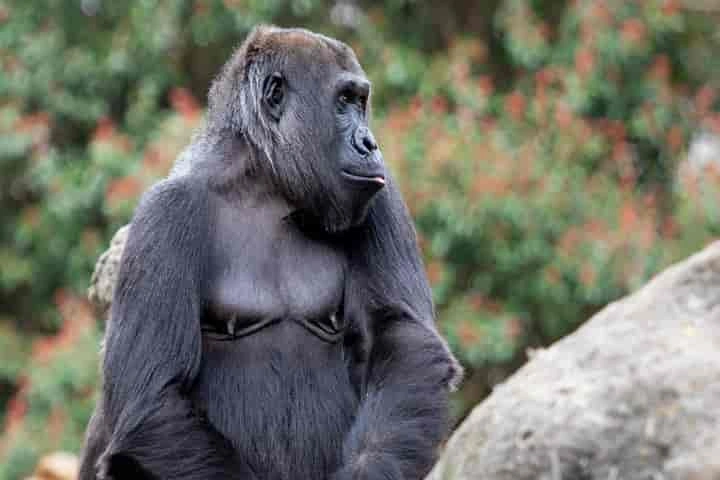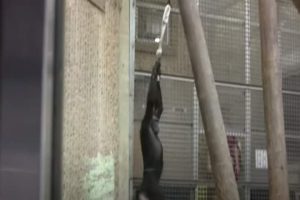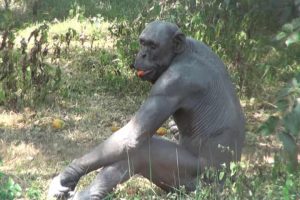Adaptation is an integral part of all living beings and that is what makes them survive in an environment which is changing. This attribute has come to the notice of scientists in a gorilla called Sukari and others at Zoo Atlanta in the US.
As per a report in sciencenews.org, Sukari is able to grunt, grumble and hum and now she has added what is called “snough” – a new way of expression – to her repertoire.
“Snough” is like a mix of a cough and sneeze which she along with other gorillas make when they sense the presence of zookeepers with food near them.
The expression is uncommon and has not been noticed in the wild and never found to be used by this species. It enables these primates to get the attention of human beings, observed Roberta Salmi, who is a primatologist at the University of Georgia in Athens.
We set up our GoPro in the gorilla habitat during Floyd’s naming event last week, but while we missed Lulu and soon-to-be-named Floyd make their pick among the ice “cakes,” we got a great view of Sukari! #OnlyZooATL #SilverbackStory pic.twitter.com/9aiPrUeC1p
— ZooATL (@ZooATL) September 30, 2019
According to Salmi and her colleagues, whose study was published PLOS ONE, a peer-reviewed open access scientific journal, snough is an important addition to the small pile of proofs that these apes in captivity are capable of producing novel vocal sounds.
Years ago, it was at the Zoo Atlanta, Salmi came across the snough when she and a zookeeper observed gorillas making a different and strange sound. Recalling that moment, she said: “We actually laughed.”
Even though these apes emit varied sounds, the snough was exceptional. In this, the creatures hiss the noise with their mouths wide open, looking as if they are getting ready to yodel. “It’s very theatrical,” Salmi said.
What makes this sound interesting and significant is that it is used during a particular instance – when keepers turn up with food. To confirm this and also check if this expression was used on any other occasion, Salmi and her colleagues decided to record eight western lowland gorillas at the Zoo and that too in three different situations or scenarios. These included when fresh grapes in a bucket or a keeper or a keeper with grapes in his or her hands was stationed outside their enclosure.
These animals snoughed maximum when both the food and keeper were close by. Besides this, they also used other means to attract the attention of human beings which included chest-beating, clapping or banging on the enclosure. On seeing either just the grapes or just the keeper, the primates mostly kept quiet.
Commenting on this, Zanna Clay, who is a primatologist at England’s Durham University said: “That’s quite decent evidence of the animals’ intention to request something from the keeper.” Clay was not involved in the study.
It is noteworthy that snoughing wasn’t restricted to gorillas of Zoo Atlanta. In the data collected from surveys done in 19 zoos spread across US and Canada it was found that other gorillas too made this snuffling sound. What was observed is that they weren’t able to make the snough sound that the Zoo Atlanta gorillas were capable of. This could be due to the fact that they had never been exposed to one another.
While the scientists are unable to pinpoint as to how snough came into being, Clay notes that the expression of sneezy cough is to attract the attention of the keepers. “Coughing and sneezing are signs of a cold, which are signals that caregivers pay specific attention to.”
Unable to physically reach something, gorillas may be “trying to use communicative signals to manipulate humans” into providing them help, Jared Taglialatela said. Taglialatela, who was not part of the study, is an evolutionary biologist in Georgia’s Kennesaw State University.
Till now, the study of vocal range of apes has been limited to other relatives of gorillas like chimpanzees who are known to blow “raspberries”; and orangutans who can whistle. By that yardstick, calls of gorillas have not been studied well. “There’s a bit of a gap in our understanding,” Taglialatela said.
Now that it is known that chimpanzees, orangutans and at present gorillas are capable of creative vocalisations like human beings, then this ability may have been common to the ancestors of these animals and people too, observed Taglialatela.
By studying gorillas, Clay feels we can understand better how language develops and what pushes its development.




















